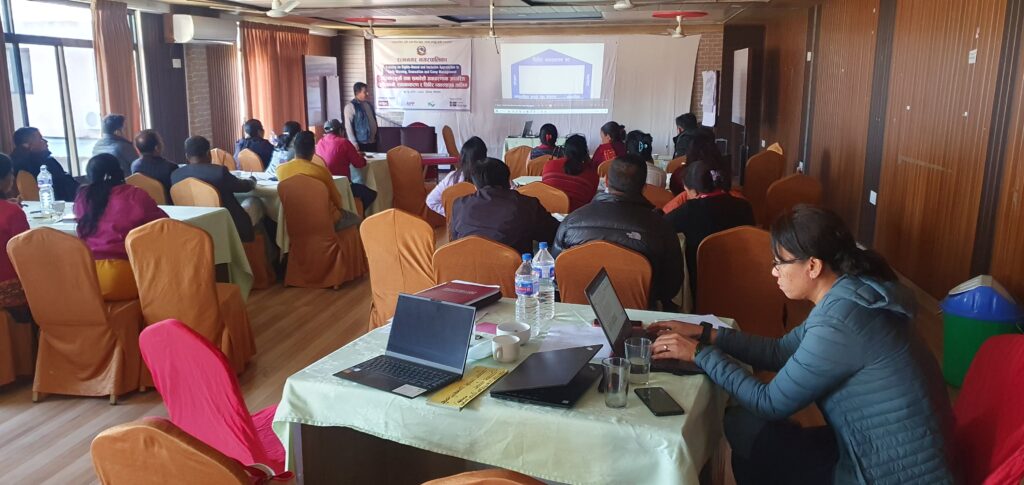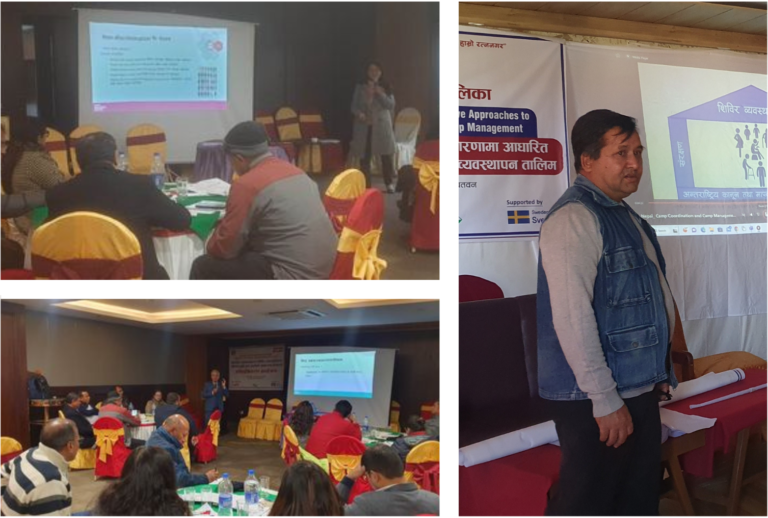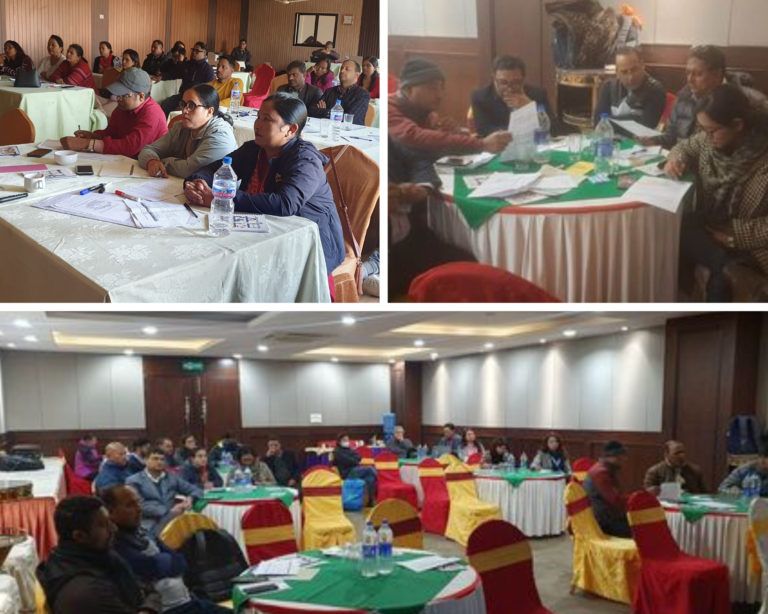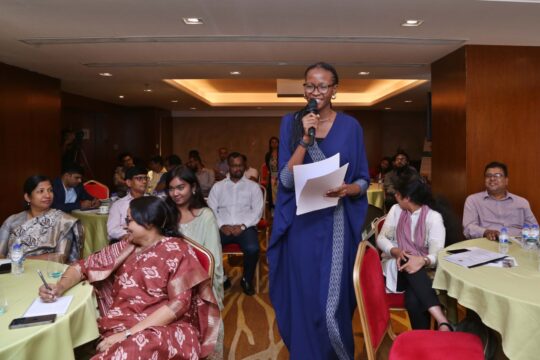
The Nepal Preparedness Partnership (NPP) organized training to introduce Framework to Integrate Rights and Equality (FIRE) – a four-module course that is based on rights-based and inclusive approaches to early warning, relocation, and camp management during a disaster. The training sought to create an environment where the framework’s approach can be practiced at the local as well as national level programs and training courses. It was facilitated by the resource persons who previously participated in the Regional Level training of FIRE. The local level training was hosted by Ratnanagar Municipality of Chitwan district, Nepal in close coordination and support of the Asian Disaster Preparedness Center’s (ADPC) program- Building Resilience through inclusive and climate-adaptive disaster risk reduction in Asia-Pacific (BRDR). Likewise, at the national level, the Ministry of Federal Affairs and General Administration (MOFAGA) supported organizing the training. The session at Sauraha, Chitwan District, took place on 1 – 2 December 2022 with 35 participants (17 males, 18 females). While the session at Baneshwor, Kathmandu, session took place on 22 – 23 December 2022 with 28 participants (19 males, 9 females).
Summary of the discussion:
- Human rights should be the foundation of any aid or development endeavors. However, this has been often overlooked during disaster management even though disaster-affected communities are suffering often and those rights are mostly denied or not being met.
- Necessary coordination methods, policies, and laws should reflect international commitments related to questions of rights and inclusiveness. These actions are the responsibility of service providers from the central to local levels.
- There must be mechanisms to ensure accountability and transparency, including grievance and complaint procedures for affected communities and access to decisions by those affected, etc.
- Relocation is the responsibility of the state to protect families or communities that are at risk of disaster. The local level authorities have been assigned the responsibility of identifying such settlements or communities and relocating them to safe places but is not backed up by necessary data on the number of households and at-risk populations.
- Inadequate budget and programs for the development, operation and capacity building of the concerned local government early warning system (ESW) have led to unsatisfactory management of the early warning at the community level.
- Inadequate mechanisms to ensure accountability and transparency, including grievance and complaint procedures for affected communities and access to decisions by those affected are very generically and symbolically exercised.
- The foundation for any humanitarian aid or development endeavors is the universal declaration of Human rights. This is being disregarded in the practical application during disaster management phases. The lack of commitment or institutionalization of it has often led to increasing the sufferings of the disaster-affected communities and denial of their basic rights to survival.
- Relocation is the responsibility at the state level in the federal structure. They are mandated and assigned with the responsibility to relocate and protect families or communities that are at risk of disaster. This role includes identifying such settlements or communities and relocating them to safe places, which generally is not supported with factual and necessary data on the number of households and at-risk populations.
- Inadequate budget and programs for the development, operation, and capacity-building of the concerned local government EWS have led to unsatisfactory management of the early warning at the community level.
- There is a requirement for coordination methods, inadequate and specific policies, and laws reflecting international commitments on issues of rights and inclusiveness that need to improvise further.

Key takeaways:
- Training on rights and inclusive development enables locally elected representatives to implement these learnings and understandings during policy formulation or implementation in their municipalities to recognize the value of human/fundamental rights of diverse people during disasters.
- Sufficient time for group exercise supports facilitating a better understanding of the local scenario through lively discussion and cross-learning.
- The right-based and inclusive elements are being generically practiced at the local levels and the introduction of such an integrated and comprehensive framework supports clarifying the essence of the issues by consolidating the fragmented approach into a single framework.
- Simplified training methodologies add value to the learning and understanding process, which needs to be supported by national examples or scenarios suitable for the local context.
- Learnings and understandings from training on rights and inclusive development empower representatives and authorities to implement them during policy formulation and implementation in their organizations and institutes to acknowledge the value of fundaments human rights of diverse people during disasters.
- Simplified training methodologies add value to the learning and understanding process, which needs to be supported by national examples or scenarios suitable for the local context.
- Sufficient time for group exercise supports facilitating a better understanding of the local scenario through lively discussion and cross-learning.
- Introducing a consolidated comprehensive framework supports clarifying the essence of the fragmented approach issues on right-based and inclusive elements that are being generically practiced during disaster management phases.
Way forward:
- Local-Level policies and guidelines should ensure that human rights are protected and respected during disaster management to alleviate the sufferings of the affected communities in practice.
- The local level has to dedicate more resources to identifying at-risk settlements or communities, feasible safe places, and appropriate and updated data on the number of households and at-risk populations.
- Improvise coordination methods, and approaches, to reflect international humanitarian commitments into local-level policies and directives need to be scaled up.
- Allocating adequate budget and programs for the sustained operation, and capacity building of the local government to establish and manage an EWS at the local level.
- Stakeholders must dedicate more resources at the national level to identify at-risk settlements or communities, safe places, and appropriate and updated data on the number of households and at-risk populations.
- Allocating adequate budget and programs for the sustained operation, and capacity building of the local government to establish and manage an EWS at the local level requires greater prioritization.
- National policies and guidelines should ensure that human rights are protected and respected during disaster management to alleviate the sufferings of the affected communities in practice.

Participants from the training shared their outlooks:
Mr. Kiran Mahato, Ward Chairperson of Ratnanagar Municipality-6 – “The training learning, skills, and understanding need to be applied at the local level. After being elected as the ward chairperson, I have had the opportunity to in similar training. It has changed my perception and ability of disaster management especially when it comes to protecting the rights of vulnerable people. I believe this collaborative initiative to organize this training is so important to improving leadership.”
Ms. Sita Kumari Ranpal, Ward member of Bharatpur Metropolitian-11 – “The training has refreshed and corrected the conventional practices we learned. We had been too focused on the charity aspects of relief distribution with inadequate skill and knowledge of SPHERE standards and integrating rights and equality in disaster risk reduction (DRR) and development work. The knowledge accumulated here will guide and make us more accountable while protecting the rights of the people in disaster management.”
Mr. Sher Bahadur Karki, Nepal Red Cross Society; “The training has provided me with insights that activities conducted during and after disaster events were being executed with insufficient theoretical clarity. Some new and very effective and thought-provoking issues have been highlighted today that include what actions are taken after disasters, the stakeholders to take these actions, and how they will do it. Though these are an integral part of any response plan in every cluster, effective implementation has not been possible due to the absence of a common understanding among all actors. I am confident that this training manual will be helpful to bring uniformity in understanding of the actors working in the humanitarian fields”.
Mr. Pallava Pant, Atulya Foundation; “The interventions for the safety and protection of persons with different disabilities during disasters while the said actions are primarily theoretical. This training has drawn everyone’s attention toward necessary actions. Our foundation has prepared a training manual to enhance the knowledge of DRR for disabled persons that has been endorsed by the Ministry of Home Affairs (MoHA). The input on the training manual with further support when we implement it.
Mr. Lilanath Sapkota, National Administrative Staff College, “The FIRE should be taken seriously as an avenue to enhance inclusive DRR. We need to apply the same response actions to ensure inclusive actions that consider the rights of the affected. This FIRE manual will be a guide to agencies working in the humanitarian sector. It needs to be institutionalized after modification based on the suggestion and feedback received.”
Mr. Dayasagar Shrestha, DiMaN, “The FIRE training manual is very comprehensive, and it will help everyone to make the response work productive and inclusive during the disaster. I would recommend this manual be further included in the wider discussion. It will be a guide for agencies working in the humanitarian sector and he requested that it be discussed extensively with the stakeholders and given the final form.”


